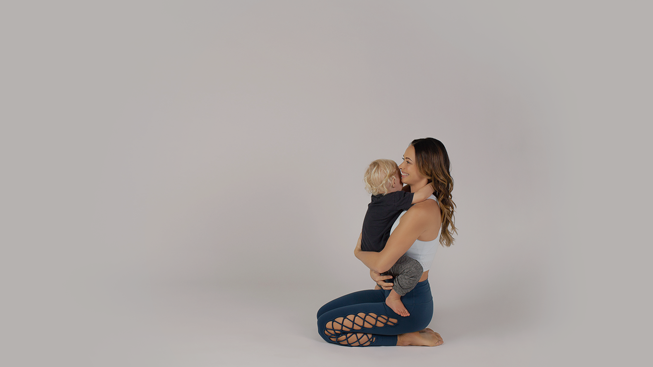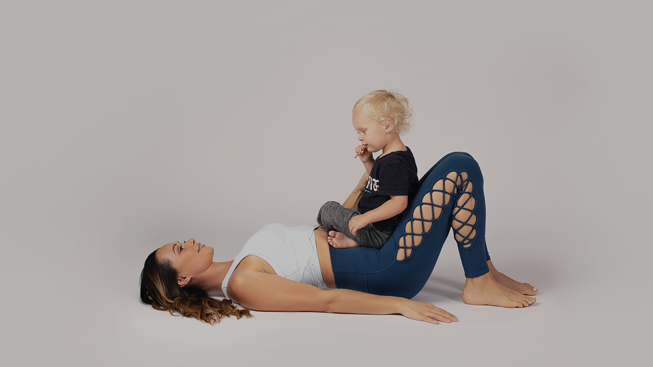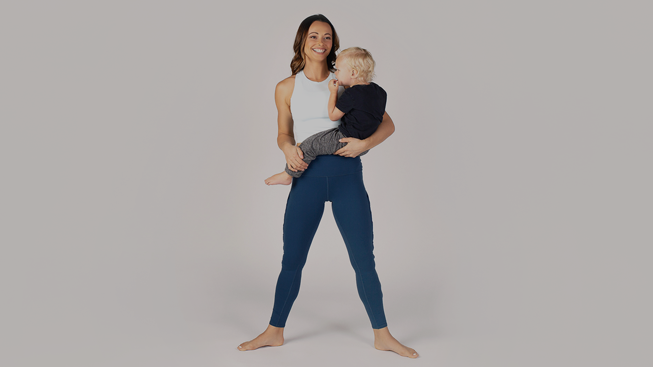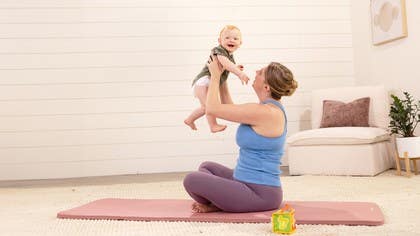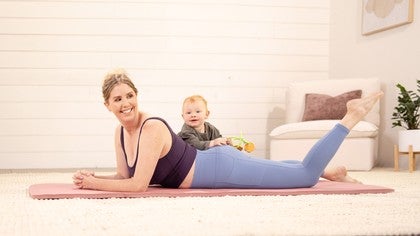Postpartum/Postnatal Pilates Guide
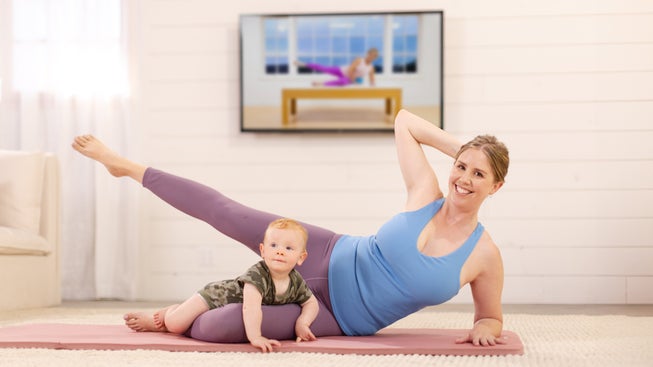
About Postpartum Pilates
Postpartum Pilates (or postnatal Pilates) is one of the best forms of self-care moms can do, promoting total-body alignment, better posture, and enhanced mind-body awareness of your “new” post-baby body, which work hand in hand to prevent issues like lower-back pain, as well as shoulder tightness and neck tension. The intentional deep breathing during Pilates oxygenates both the muscles and the brain, which translates to increased mental clarity and patience. The boost in circulation you’ll get from engaging in Pilates movement will energize your body from head to toe, something that proves especially helpful for sleep-deprived parents.
What are the benefits of postpartum Pilates?
Postpartum Pilates is specifically designed for the postpartum body—and that includes women who have underwent both vaginal deliveries and C-sections. Once your doctor gives you clearance to begin movement, Pilates can help accelerate the healing process, boosting blood flow and oxygenation to help repair damaged muscles like the transverse abdominis (your deepest abdominals that form a “corset” around your torso) and your obliques.
Is postpartum Pilates safe?
Doing Pilates or another form of moderate exercise after birth is a safe and effective way to address any aches and pains still lingering from pregnancy and from the physical and mental demands of being a new mother. Although most experts advise waiting six to seven weeks to begin working out, gentle Pilates-based movement and deep breathing can help increase mobility and circulation right after baby arrives. Since Pilates is mind-body movement, it also works in tandem with the nervous system to make new brain-body connections, which is essential to the natural healing process.
Postpartum Pilates Exercises
Lunge to Kneeling Combo
Lunge to Kneeling Combo
This Lunge to Kneeling Combo will challenge your stability and glute strength. You will also improve your posture by focusing on keeping your spine long. Repeat on each side.
Roll Up
Roll Up
This gentle Roll Up will help you rebuild your abdominal strength and improve the mobility of your spine.
Bridge
Bridge
This Bridge exercise will strengthen your hamstrings and glutes. Plus, you can challenge your stability with a Single Leg variation. Repeat on each side.
Grand Plié
Grand Plié
The Grand Plié in second position will work your inner thighs and hips as you move in this externally rotated position.
Postnatal Reformer Exercises
Doing postnatal Pilates on the Reformer can be an accelerated way to help safely rebuild strength and stability in the postnatal body. It’s best to do Reformer Pilates under the supervision of a qualified instructor, who has the proper knowledge on the postnatal body and its limitations. Above all, it’s crucial to regain your understanding of how to engage the transverse abdominis (the muscle group that allows you to “corset” your midsection). When you engage this deep layer of abdominals, you’re able to support your torso and back, which will lead to safer, more efficient movement. Examples of effective Postnatal Reformer exercises include: Footwork; Arm work; exercises with your legs in the straps like Frogs; Pulling Straps while seated on the Long Box; Rowing; Mini Swan; Chest Expansion; and Side-Lying work.
Postnatal Mat Exercises
Doing postnatal Pilates on a Mat is an even more accessible way to reap similar benefits, especially if you’re short on time like most new moms. Even if you just have 10 or 15 minutes, a quick mat workout—with exercises, including Half Roll-Back, Rolling Like a Ball, Shoulder Bridge, the Side-Lying Leg Series, and Mermaid—in your living room can work wonders. Props like the Magic Circle can simultaneously add support and challenge to your home practice. Whether you’ve experienced a vaginal delivery or a C-section, most postnatal Pilates Reformer and Mat exercises will be appropriate. Above all, it’s important to go at your own pace and to seek the guidance of a Pilates instructor experienced in postnatal Pilates.
Postnatal Pilates Exercises to Reclaim Your Core
Recommendations
Precautions and Modifications
If you’re unable to work with a postnatal Pilates specialist, it’s vital to understand which Pilates exercises are inappropriate for the post-baby body. This will come in handy when you opt for a quickie mat workout while baby naps! Avoid back-extension exercises like Swan and Swimming right off the bat. The majority of new mothers have a forward kyphotic (slumped) posture, the result of holding and feeding baby and having full breasts. Before you engage in any form of back extension, focus on opening your chest and shoulders. That way, you’ll reap the benefits of back-bending without injuring your body.
Postpartum Stress
Pilates is a great way to manage postpartum stress, which is the anxiety, stress, and general fogginess that many mothers experience in the weeks or months after childbirth. Even doing just 10 minutes of mindful movement like postnatal Pilates can help reduce stress, improve sleep quality and make you feel invigorated, both physically and emotionally. Motherhood, especially when it’s your first time, can be challenging and taxing. Postnatal Pilates is an effective tool you’ll want to turn to over and over again.
Exercises to Avoid
Exercises that might be counterproductive for the postnatal body include anything that causes extra intra-abdominal pressure like Planks, Push-Ups, and Sit-Ups. If you enjoy lifting weights to supplement your Pilates, opt for lighter weight, especially while squatting or doing deadlifts.
C-section
If you’ve had a C-section, make sure to ease into your Pilates practice, gently reintroducing abdominal work and only progressing when you’re fully ready. Only you know your body and what you’re feeling, so let it be your guide.
Related Articles
Diastasis Recti Frequently Asked Questions
What is Diastasis Recti?
Diastasis recti is an excessive widening and thinning of the linea alba, or the tissue on the right and left side of the abdominals. Diastasis recti is a prevalent issue among postpartum women.
What precautions should I take?
If you have diastasis recti, stay away from forward flexion (exercises like The Hundred or Series of Five done with the head and neck up), since these place too much load on the abdominals and pelvic floor and can potentially exacerbate the issue. The last thing you want to do is to make that separation worse.
Is postnatal Pilates safe?
Postnatal Pilates is not only safe for most women with this abdominal separation, but it can actually help to support regeneration of the abdominal tissue. Pilates is also beneficial for any pelvic floor issues that might have occurred during pregnancy or labor and delivery (such as tearing), which can cause shooting pain, pain during sex, and problems with bladder function, such as urinary incontinence.
Your Pilates Anytime Membership Benefits
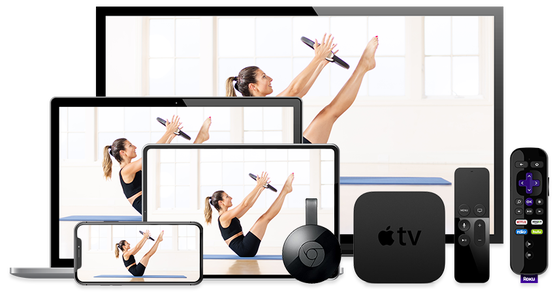
- 15-Day Free Trial
- Unlimited Access to Thousands of Classes
- 95+ Pilates Programs and Challenges
- No Ads
- New Videos Weekly
- Available on All Your Favorite Devices
